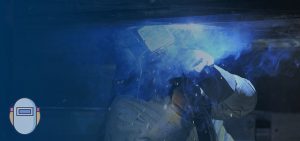Acting and future professional welders are usually aware of more than 30 types of welding procedures.
However, welders most often use only three of them.
They are SMAW, GMAW/MIG, and TIG.
Shielded metal arc welding, gas metal arc welding (or metal inert gas), and tungsten inert gas welding are different.
What are the differences between them and what do these methods have in common?
Shielded Metal Arc Welding
Out of habit, we call SMAW a stick welding where a welder uses a metal rod to join materials manually holding the electrode in a torch with a clamp.
In the process of welding, the contents of the solidly coated rod demolish.
By doing so, you protect the metal that melts with an inert gas cloud.
As a result, you remove all of the oxygen that could possibly contact with metal and separate a stony waste matter called ‘slag’.
SMAW method has its disadvantages too.
One of the biggest drawbacks of using this method is the weakness of final metal structure due to eventual infiltration of slag into the weld.
Gas Metal Arc Welding
Simply put, GMAW is a subset of MIG (metal inert gas welding).
In this process, a welder applies a roll of wire with a special welding “gun”.
Unlike the SMAW method, MIG does not require you to stop in the middle of welding to change welding rods.
A wire is easier to use when you expect a long process of welding.
Therefore, welding professionals recommend GMAW method as one of the easiest to learn to weld fast.
No slag can be seen at the weld because argon and CO2 displace oxygen.
Nevertheless, you will need a controller and a storage chamber for the metal inert gas welder.
Tungsten Inert Gas Welding
While SMAW and GMAW are the methods in which the electrodes are consumed during the process of welding, TIG is non-consumable.
This means that the weld does not consume the electrode so it does not become a part of the workpiece.
Similarly to MIG, as a welder, you will need a special tank and inert gas to get the metals shielded.
Just like in GMAW, argon protects and cools tungsten during the welding process.
Compared to gas metal arc welding as the easiest method of joining metals, TIG is one of the most complicated ones.
An explanation is that a filler rod must be in one hand of a welder and the gun in the other.
Only specific types of welds require tungsten though.
This page is also available in Spanish.











